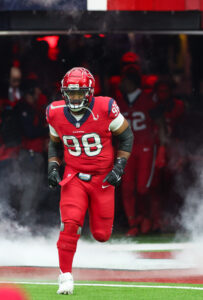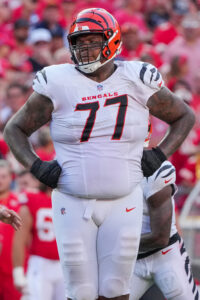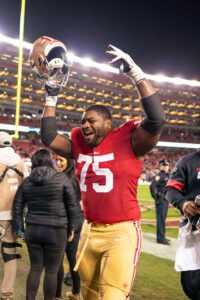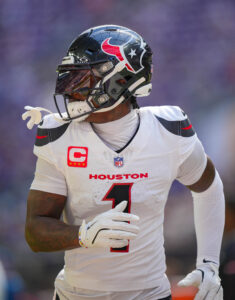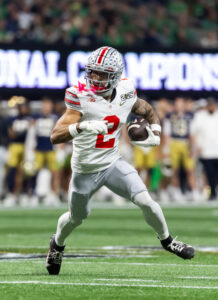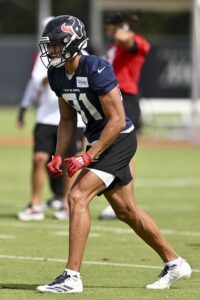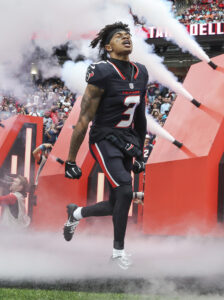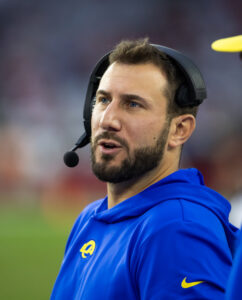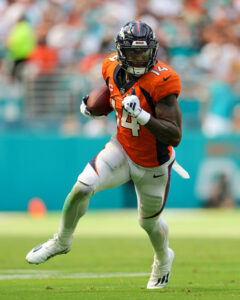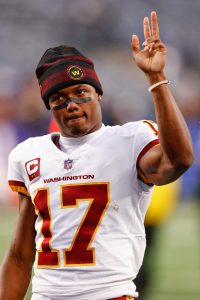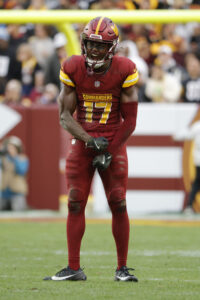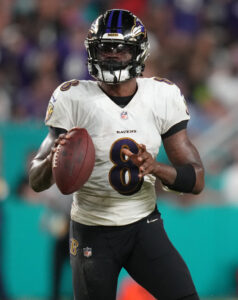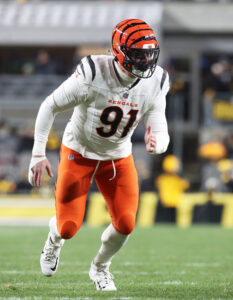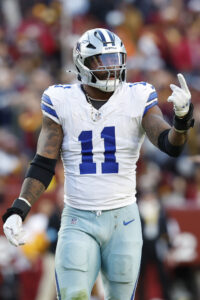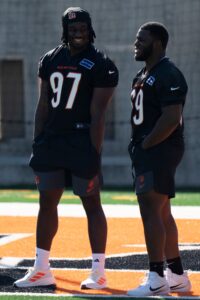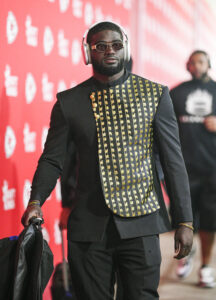After authorizing the three biggest contracts in team history, the Jaguars moved through a disastrous season. The team’s 4-13 campaign led to Doug Pederson‘s ouster, as the former Super Bowl-winning HC’s fate became easy to predict as the season’s final weeks transpired. The team’s initial offseason plan, however, took on water as it became clear GM Trent Baalke‘s presence was interfering with the search to replace Pederson.
A course change midway through led the Jaguars to their eventual Liam Coen–James Gladstone pairing. This brings far less experience compared to Pederson-Baalke, but Jacksonville had seen its fortunes worsen as that pair’s third season ended. Coen will be asked to elevate Trevor Lawrence to justify the $55MM-per-year contract awarded last year, and the new regime’s defining move equipped the former No. 1 overall pick with one of the most unique weapons in NFL history.
Coaching/Front Office:
Before Travis Hunter became in play for the Jaguars, they needed to sort out their leadership positions. It took a bit. Pederson, though, received an early pink slip. He was the only coach fired on Black Monday this year, and although reports of uncertainty did emerge late in the season, it was not hard to see where the situation was heading. After a 9-8 2022 season that featured a Lawrence-led 27-point comeback win over the Chargers in the wild-card round, the Jags were 8-3 and sniffing the AFC’s No. 1 seed a year later. They finished Pederson’s tenure with five wins in their final 23 games.
 Lawrence’s health, a non-issue until his third season, hurt the Jags in this span. But the former Clemson super-prospect has not developed as the team hoped. The Jags ranked 24th offensively last season, one that ended with Lawrence sidelined due to a concussion and a nonthrowing shoulder injury that required surgery.
Lawrence’s health, a non-issue until his third season, hurt the Jags in this span. But the former Clemson super-prospect has not developed as the team hoped. The Jags ranked 24th offensively last season, one that ended with Lawrence sidelined due to a concussion and a nonthrowing shoulder injury that required surgery.
Pederson’s first Jacksonville season brought a 10th-place offensive ranking, the best of his tenure, with the HC being the primary play-caller. The veteran coach, however, gave OC Press Taylor the call sheet before the 2023 season and kept outsiders in suspense about his play-calling plans for 2024. Shad Khan even voiced support for Pederson taking the reins back, but Pederson stuck with Taylor — a development that reminded of the HC’s Eagles undoing.
Pederson had aimed to have Taylor promoted to Eagles OC in 2021, but ownership was not onboard. This helped lead to a split. Pederson brought Taylor with him to Jacksonville and stuck with him as play-caller for the past two seasons, even as the walls tumbled down. Pederson firing Mike Caldwell as DC did not bring a 2024 boost, as the Jags regressed in both points and yards allowed (dropping to 27th and 31st in those categories, respectively) under Ryan Nielsen. Josh Hines-Allen and Tyson Campbell joined Lawrence in failing to justify their 2024 paydays.
While Pederson’s tenure did not reach the depths of Gus Bradley‘s or Doug Marrone‘s, Khan gave him less time by moving on after three years. That came months after the owner labeled the 2024 Jags as the most talented roster in team history. Khan attempted to have only Pederson take the fall, keeping Baalke on to help hire the next HC. Although Khan stopped short of guaranteeing Baalke would remain GM, coaching candidates certainly assumed that would be the case (even Pederson had been hesitant about the then-GM in 2022).
This created a disjointed search, as both Aaron Glenn and Ben Johnson had reservations about Baalke. This contributed to Johnson choosing the Bears despite the coveted candidate’s reported Jags interest. The Jags then saw Coen decline a second interview, bowing out of their search and agreeing to a Buccaneers extension worth roughly $4.5MM per year on January 22nd. The Bucs’ extension offer was contingent on Coen not taking a second Jaguars meeting, but once he realized he held a strong chance at landing the Jags gig, another raise ask occurred. Bucs ownership declined it, however. This sequence proved to be an important stretch regarding the Jaguars’ big-picture direction.
 Hours after Coen backed out on his second meeting, Khan fired Baalke. The owner did so despite claiming a full-on overhaul would be “suicide” for the franchise. Signaling the GM was the primary hang-up, Coen circled back and met with the Jags. This then involved Coen avoiding Bucs contact, telling Todd Bowles he was dealing with a personal matter, as a clandestine mission in north Florida commenced.
Hours after Coen backed out on his second meeting, Khan fired Baalke. The owner did so despite claiming a full-on overhaul would be “suicide” for the franchise. Signaling the GM was the primary hang-up, Coen circled back and met with the Jags. This then involved Coen avoiding Bucs contact, telling Todd Bowles he was dealing with a personal matter, as a clandestine mission in north Florida commenced.
An agreement emerged Jan. 23. The one-and-done Tampa Bay OC certainly burned bridges on the way out of town — to the point the Bucs blocked two assistants from becoming Coen’s O-line coach — but he secured stunning power given his limited experience and history of leaving jobs quickly.
The Jaguars’ 2024 struggles prompted Khan to hand the keys to Coen. This came four years after the owner placed Urban Meyer atop the personnel pyramid. With Pederson not doing enough in between, the Jags are a coach-centric operation again.
Coen, 39, has not stayed in the same job since his first Rams stint in the late 2010s. Sean McVay hired Coen as assistant wide receivers coach in 2018 and moved him to assistant QBs coach in 2020. Coen then bounced from Kentucky to the Rams and back to Kentucky — all in OC roles — before yo-yoing back to the NFL with the Bucs, who gave the young coach his first NFL play-calling shot.
The 2022 Rams did not impress, but Coen coaxed a breakout Will Levis junior season (2021) and later helped Baker Mayfield build on his 2023 resurgence. Mayfield established career-high marks across the board last season, throwing 41 TD passes and completing 71.4% of his throws. This came as he reached a career-best 7.9 yards per attempt, checking enough boxes for Coen to follow Dave Canales in receiving a head coaching offer after one season as Bucs OC. Robert Saleh, who worked under Bradley in Jacksonville, was believed to be the team’s fallback option if Coen did not reconsider his stance.
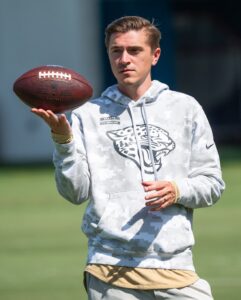 Rumors over the past several years paint a grim picture of life during a Baalke GM stay. The 49ers keeping their GM over Jim Harbaugh in 2015 proved a mistake, as the team sunk to its lowest depth since the late 1970s, and the Jags’ 2022 HC search featured hiccups involving the GM. Khan firing Meyer increased Baalke’s organizational power ahead of a draft that brought a Travon Walker-over-Aidan Hutchinson pick. An early-season report last year also depicted friction between Baalke and Pederson, with Taylor’s status a point of contention.
Rumors over the past several years paint a grim picture of life during a Baalke GM stay. The 49ers keeping their GM over Jim Harbaugh in 2015 proved a mistake, as the team sunk to its lowest depth since the late 1970s, and the Jags’ 2022 HC search featured hiccups involving the GM. Khan firing Meyer increased Baalke’s organizational power ahead of a draft that brought a Travon Walker-over-Aidan Hutchinson pick. An early-season report last year also depicted friction between Baalke and Pederson, with Taylor’s status a point of contention.
Baalke following Tom Telesco off the GM tier this offseason means no second-chance GMs are currently employed, illustrating the high stakes these jobs carry. No team has hired Baalke or Pederson, and the Jags’ midwinter changeup brought in Gladstone, who is the NFL’s youngest GM (at 34).
Gladstone spent nine years in Los Angeles, rising from an assistant to the general manager position to director of scouting strategy. The Jags were Gladstone’s only GM connection, and it came after reported Coen preference Mike Greenberg, the Bucs’ assistant GM, declined an interview. Bears assistant GM Ian Cunningham also checked in as an early frontrunner. Gladstone and Coen worked together for four nonconsecutive seasons in L.A., and the former had worked under Brad Holmes before he became the Lions’ GM.
 The Rams have an established history of finding draft gems in the McVay era, and their 2023 and ’24 drafts — efforts that helped create a formidable pass rush as Aaron Donald exited — reflected well on their scouting strategy chief. Seeing Holmes do wonders in Detroit, the Jags will roll the dice on a young exec. He joins Coen and Boselli as part of a decision-making troika, but the HC is atop the pyramid.
The Rams have an established history of finding draft gems in the McVay era, and their 2023 and ’24 drafts — efforts that helped create a formidable pass rush as Aaron Donald exited — reflected well on their scouting strategy chief. Seeing Holmes do wonders in Detroit, the Jags will roll the dice on a young exec. He joins Coen and Boselli as part of a decision-making troika, but the HC is atop the pyramid.
Coen did not hire an experienced OC. Udinski rises from Vikings assistant quarterbacks coach to this post. Even though the Jags’ OC position is currently a non-play-calling gig, this represents quite the vault for a 29-year-old assistant. Udinski landed this job after candidate Nate Scheelhaase bowed out to stay with the Rams.
Like Gladstone, Udinski rose from the “assistant to the” level. This climb, however, occurred within a two-year span. Kevin O’Connell made Udinski his assistant QBs coach in 2023, and Sam Darnold‘s belated breakthrough garnered attention for the staff. Udinski becoming an OC before Vikes QBs coach Josh McCown is interesting, but O’Connell — Coen’s Rams boss in 2020 — has become one of the NFL’s most respected coaches. This represents the first major branch off his coaching tree.
Campanile, 42, has no history with Coen or Gladstone. He spent four years in Miami as linebackers coach, arriving under Brian Flores and being retained by both of Mike McDaniel‘s first two DCs. Campanile only interviewed for the Jags’ DC job this year but met with the Dolphins and Giants about their positions in 2024. The Jaguars are now on their fifth DC of the 2020s. Nielsen has now been a one-and-done DC in New Orleans, Atlanta and Jacksonville over the past three years, managing to pull this off without technically being fired. The 2022 Saints co-DC took the Falcons’ job in 2023 and was subsequently tied to two canned HCs.
Trades:
Among the extensive receiver turnover in Jacksonville, this move stands out. The team was prepared to release Kirk, who turned heads with his $18MM-per-year contract as a 2022 free agent, but collected a low-end return from a division rival. While dealing Kirk to the Texans may have signaled the new staff’s view of his abilities, this is more of a salary dump from a regime that had no ties to Lawrence’s previous top target.
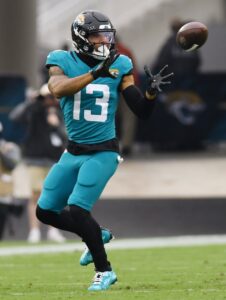 Kirk is still just 28 and delivered two impressive seasons in Jacksonville. Proving the Baalke-Pederson regime right for a market-reshaping contract — via the wave of deals made after Kirk’s — the former Cardinals second-round pick helped elevate Lawrence with an 1,108-yard 2022 showing and was more productive on a per-game basis in 2023. The slot weapon averaged a career-high 57.6 yards per game in 2023 but went down with a core muscle injury early in Week 13. That setback coincided with the Jags’ swoon, as they were 8-3 in the games Kirk finished that season.
Kirk is still just 28 and delivered two impressive seasons in Jacksonville. Proving the Baalke-Pederson regime right for a market-reshaping contract — via the wave of deals made after Kirk’s — the former Cardinals second-round pick helped elevate Lawrence with an 1,108-yard 2022 showing and was more productive on a per-game basis in 2023. The slot weapon averaged a career-high 57.6 yards per game in 2023 but went down with a core muscle injury early in Week 13. That setback coincided with the Jags’ swoon, as they were 8-3 in the games Kirk finished that season.
A broken collarbone shelved Kirk last season, denying teams — including the then-WR-fixated Steelers — a chance to make trade offers near the deadline. The Jags moved on from Kirk’s $15.5MM 2025 salary in the final year of the contract, saving $10.44MM as a result. Though, the Coen-Gladstone regime did OK a $13MM-plus dead money hit via this trade. The Jags have made two significant WR investments in the past two drafts, lessening the blow to Lawrence.
Free agency additions:
- Patrick Mekari, OL. Three years, $37.5MM ($20MM guaranteed)
- Jourdan Lewis, CB. Three years, $30MM ($20MM guaranteed)
- Robert Hainsey, C. Three years, $21MM ($10MM guaranteed)
- Eric Murray, S. Three years, $19.5MM ($10MM guaranteed)
- Dyami Brown, WR. One year, $10MM ($9.5MM guaranteed)
- Chuma Edoga, T. Two years, $7MM ($3.2MM guaranteed)
- Hunter Long, TE. Two years, $5MM ($3MM guaranteed)
- Nick Mullens, QB. Two years, $4.5MM ($3MM guaranteed)
- Johnny Mundt, TE. Two years, $5.5MM ($2.26MM guaranteed)
- Emmanuel Ogbah, DE. One year, $3.25MM ($2MM guaranteed)
- Dennis Gardeck, DE. One year, $2MM ($1.5MM guaranteed)
- Dawuane Smoot, DE. One year, $1.5MM ($1.5MM guaranteed)
- Fred Johnson, T. One year, $1.34MM ($1.14MM guaranteed)
- Quintin Morris, TE. One year, $1.15MM ($365K guaranteed)
- Trenton Irwin, WR. One year, $1.17MM
One of the league’s most versatile players, Mekari has seen at least 200 snaps at all five O-line positions. His work at guard in 2024, however, set a quality free agent market in March. The Ravens had slotted Mekari as a swing backup but needed him at left guard last season. Jacksonville will slide Mekari to right guard, as Ezra Cleveland is in place at LG. This contract represented a value vault for Mekari, who played out a three-year, $15.45MM deal.
 ESPN’s pass block win rate metric ranked Mekari fifth among guards last season, marking an impressive showing given that the versatile blocker’s primary position was tackle from 2021-23. The Jags are not certain 2023 first-round pick Anton Harrison will remain their RT starter, so it is possible Mekari could be tapped to take over there. His projected 2025 spot will be RG, however.
ESPN’s pass block win rate metric ranked Mekari fifth among guards last season, marking an impressive showing given that the versatile blocker’s primary position was tackle from 2021-23. The Jags are not certain 2023 first-round pick Anton Harrison will remain their RT starter, so it is possible Mekari could be tapped to take over there. His projected 2025 spot will be RG, however.
A $7MM-per-year deal looks like a win for Hainsey, who joined Murray and Brown among the Jags’ curious contracts on Day 1 of free agency. The Buccaneers demoted Hainsey, Ryan Jensen‘s center replacement, for first-rounder Graham Barton last year. Hainsey started a game in his contract year but played only 95 offensive snaps. Pro Football Focus was down on the former third-rounder’s center work in 2023, ranking him 32nd at the position, but viewed him as a top-15 snapper in 2022. Even as Coen only stopped through during Hainsey’s second-string season, the one-year Bucs OC signed off on a top-10 center contract to bring him to Jacksonville.
After the slot cornerback market received updates to move it past eight figures per year for the first time, a few more inside contributors cashed in. Kenny Moore and Taron Johnson did the early damage in March 2024, and Michael Carter passed them months later. This year, Lewis helped set the table for Jalen Pitre and Kyler Gordon. Lewis’ situation reminds more of Moore and Johnson’s, as Carter, Pitre and Gordon are second-contract players. Entering his age-30 season, Lewis is on his fourth contract. The Jags looked into reuniting Coen and Carlton Davis, but that market reached $16MM per year. Lewis instead became the team’s CB addition.
Read more
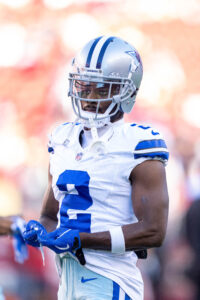 A Lisfranc injury threatened Lewis’ career while on his second Cowboys contract (three years, $13.5MM), and his return from it in 2023 merely fetched a one-year, $2.83MM deal. Despite Lewis’ age, the Jags will guarantee two years of his salary.
A Lisfranc injury threatened Lewis’ career while on his second Cowboys contract (three years, $13.5MM), and his return from it in 2023 merely fetched a one-year, $2.83MM deal. Despite Lewis’ age, the Jags will guarantee two years of his salary.
This is a slight risk due in large part to age, but Lewis is fully back from his foot issue, having played 16 games in 2023 and ’24. After not viewing Lewis as an effective cover man in his first year back, PFF rated him as a top-30 corner in 2024. He served as Dallas’ primary slot CB for eight seasons, and the Jags will hope the former third-rounder’s prime will stretch into one more season.
Jags WR signings have drawn scrutiny in the past, as the team’s Kirk and Zay Jones accords remind. Brown only signed a one-year contract, but his minimal production in Washington invites questions about this deal.
As the Commanders searched for a Terry McLaurin complement, Brown did not eclipse 200 receiving yards in a season until 2024. The former third-rounder posted 308 with one touchdown last season. For his career, the North Carolina alum has four TDs. Yet, the Jags are preparing for the 6-footer to start alongside Hunter and Brian Thomas Jr. Brown did contribute heavily to Washington’s playoff run, totaling 229 yards in three games. But it is worth wondering if Gladstone’s Rams were high on Brown in the 2021 draft, because there is not much to go on here.
 Other than being part of the second Jalen Ramsey trade, Long has operated as an obscure presence. He has eight receptions in four seasons but has provided more value as a blocker, ranking in the top 10 (per PFF) among tight ends in the run game. Mundt’s next 175-yard season will be his first; the eight-year veteran played under Udinski in Minnesota for the past three seasons. Nontendered as an RFA by the Bills, Morris also has worked as a blocker.
Other than being part of the second Jalen Ramsey trade, Long has operated as an obscure presence. He has eight receptions in four seasons but has provided more value as a blocker, ranking in the top 10 (per PFF) among tight ends in the run game. Mundt’s next 175-yard season will be his first; the eight-year veteran played under Udinski in Minnesota for the past three seasons. Nontendered as an RFA by the Bills, Morris also has worked as a blocker.
Not that blocking is unimportant at this position, especially as rushing attacks have enjoyed a mid-2020s resurgence, but the Jags signed three with next to no NFL receiving contributions. This leaves 2023 second-rounder Brenton Strange (40 receptions, 411 yards in a 10-start 2024 season) with a clear role post-Evan Engram.
Mullens, 30, joins Mundt (30) in being older than the Jags’ new OC. Playing under Kyle Shanahan for four seasons, Mullens found a home in Minnesota via trade in 2022. He worked as Kirk Cousins‘ primary backup, making three starts as one of the Vikings’ replacement options in 2023, before playing behind Sam Darnold — and in front of Daniel Jones — as the team’s 2024 QB2. Mullens steps in as a backup as ex-49ers teammate C.J. Beathard exits. While his career numbers are somewhat Shanahan-inflated (8.0 yards per attempt), the former UDFA has made 20 career starts.
The Jags are taking a volume-based approach to stocking their EDGE backup wing. Hines-Allen and Walker are entrenched starters; they will bet on their signings being enough to round out the depth chart. The team had pursued Chase Young and Danielle Hunter at the 2023 deadline, operating as a buyer at that point, but Walker’s emergence left no need for a veteran starter in 2025.
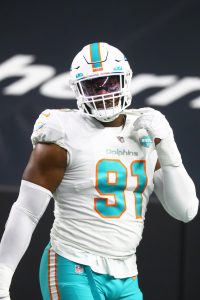 Ogbah, Gardeck and Smoot have extensive starting experience. Each is over 30, but the Jags featured woeful production from their backup edges last season. Beyond Hines-Allen and Walker, no pure Jags edge defender recorded a sack in 2024.
Ogbah, Gardeck and Smoot have extensive starting experience. Each is over 30, but the Jags featured woeful production from their backup edges last season. Beyond Hines-Allen and Walker, no pure Jags edge defender recorded a sack in 2024.
Ogbah, 31, played under Campanile from 2020-23 in Miami. The 10th-year veteran cashed in on a four-year, $65.4MM deal based on his work during that time. He has settled in as an auxiliary rusher and impressed in that role last season, totaling 5.5 sacks and nine tackles for loss. The TFL number matched his career high, generating a bigger market this offseason. Gardeck, 31 in August, suffered an ACL tear that ended his seventh Cardinals season after seven games. He posted a team-best six sacks in 2023.
Smoot, 30, returns to Jacksonville after a year in Buffalo. Smoot had been a productive Jaguar until a December 2022 Achilles tear. In the four seasons preceding that, he had racked up 22.5 sacks. With Smoot only tallying 2.5 sacks over the past two years, the Jags hope the returning role player being more than two years removed from his injury reignites him. Smoot did produce five TFLs in just 11 games last season.
Re-signings:
Notable losses:
- C.J. Beathard, QB
- Andre Cisco, S
- Ronald Darby, CB (released)
- Gabe Davis, WR (post-June 1 cut)
- Josiah Deguara, TE
- Devin Duvernay, WR (released)
- Evan Engram, TE (released)
- Luke Farrell, TE
- Blake Hance, G
- D’Ernest Johnson, RB
- Mac Jones, QB
- Jeremiah Ledbetter, DT
- Mitch Morse, C (retired)
- Josh Reynolds, WR (released)
- Keilan Robinson, RB (waived)
- Brandon Scherff, G
- Tyler Shatley, OL (retired)
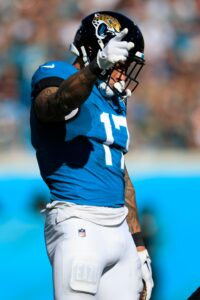 The Coen-Gladstone regime gutted Baalke’s pass-catching corps, cutting three veteran wideouts (while trading Kirk) and Engram, who had distanced himself from the field in terms of Jaguars TE production.
The Coen-Gladstone regime gutted Baalke’s pass-catching corps, cutting three veteran wideouts (while trading Kirk) and Engram, who had distanced himself from the field in terms of Jaguars TE production.
When Engram arrived as a free agency flier in 2022, the Jags had just two 700-yard receiving seasons from a tight end in their first 27 years of existence. Engram matched that in his first two, posting 766 and 963. The latter slate involved 114 catches, which trail only Jimmy Smith‘s 116-reception 1999 in team history. The former Giants first-round pick served as a vital part of Lawrence’s development, putting plenty on Strange’s shoulders this season.
Engram had been tied to a three-year, $41.25MM deal that had paid out its guarantees. The veteran receiving option, however, was set to count $19.49MM against the Jags’ 2025 cap. That proved too steep after he missed half of last season with a labrum tear. Though, the Jags both took on $13.5MM in dead money — after not designating Engram a post-June 1 cut — and saw the 2023 franchise tag recipient draw extensive free agency interest. Drawing comparable offers from the Broncos and Chargers, Engram is in Denver on two-year deal worth $23MM. Despite going into his age-31 season, Engram commanded $16.5MM at signing.
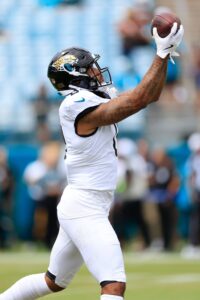 Davis joined Engram and Kirk in missing a chunk of last season due to injury. The ex-Bills WR2 had not impressed when healthy, though, finishing a 10-game season with just 239 yards and two touchdown receptions. Jacksonville had aimed to have Kirk, Davis, Engram and Calvin Ridley together on their 2024 payroll. That pricey plan did not pan out, as the Titans swooped in with a monster Ridley offer, and the other three ended the season on IR.
Davis joined Engram and Kirk in missing a chunk of last season due to injury. The ex-Bills WR2 had not impressed when healthy, though, finishing a 10-game season with just 239 yards and two touchdown receptions. Jacksonville had aimed to have Kirk, Davis, Engram and Calvin Ridley together on their 2024 payroll. That pricey plan did not pan out, as the Titans swooped in with a monster Ridley offer, and the other three ended the season on IR.
Davis remains in free agency but has drawn extensive interest. The Jags designated Davis a post-June 1 cut; he will carry $5.7MM in 2025 dead money but bring $14.6MM in penalties next year.
Scherff had protected Cousins for a stretch in Washington, and the Pro Bowl guard joined his former QB in reaching free agency after two franchise tags. As the Jags attempted to bolster a thin roster during the 2022 free agency period, Scherff received a then-record three-year, $49.5MM deal. Scherff did not quite match his prime form in Jacksonville, failing to draw a Pro Bowl invite, but the former injury-prone Washington blocker did not miss a game on his Jacksonville contract.
The Jags restructuring five-time Pro Bowler’s deal twice left them with $13.8MM in dead money based on void years (Jacksonville’s $64.7MM in total dead cap ranks seventh in the NFL). Scherff, 33, remains unsigned.
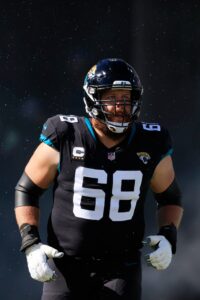 Joining Lawrence and Travis Etienne as staples acquired during the Urban Meyer draft, Cisco became a regular starter in Jacksonville. The Syracuse alum started 47 games for the team and intercepted seven passes between the 2022 and ’23 seasons. PFF viewed him as a top-40 safety in both years but graded him outside the top 60 in Nielsen’s scheme last year. The Jets turned to Cisco after the Broncos beat them out for Talanoa Hufanga. On a one-year, $8.5MM deal, Cisco can create a better 2026 market; he is only entering his age-25 season.
Joining Lawrence and Travis Etienne as staples acquired during the Urban Meyer draft, Cisco became a regular starter in Jacksonville. The Syracuse alum started 47 games for the team and intercepted seven passes between the 2022 and ’23 seasons. PFF viewed him as a top-40 safety in both years but graded him outside the top 60 in Nielsen’s scheme last year. The Jets turned to Cisco after the Broncos beat them out for Talanoa Hufanga. On a one-year, $8.5MM deal, Cisco can create a better 2026 market; he is only entering his age-25 season.
Morse becoming a Bills cap casualty preceded a Jags one-and-done, as he walked way from the second season of a two-year, $10.5MM contract. Morse, 33, did not catch on with the Jaguars at a good point but suited up for every game. The former playoff mainstay ended the season snapping to Jones, who fetched a two-year, $7MM deal from the 49ers. As Jones heads to the team he was closely tied to ahead of the 2021 draft, he scored a bigger guarantee ($4.75MM) than Darnold received from San Francisco in 2023.
Draft:
- Round 1, No. 2 (from Browns): Travis Hunter (WR/CB, Colorado) (signed)
- Round 3, No. 88 (from Vikings): Caleb Ransaw (CB, Tulane) (signed)
- Round 3, No. 89 (from Texans): Wyatt Milum (G, West Virginia) (signed)
- Round 4, No. 104 (from Browns): Bhayshul Tuten (RB, Virginia Tech) (signed)
- Round 4, No. 107: Jack Kiser (LB, Notre Dame)
- Round 6, No. 194 (from Seahawks): Jalen McLeod (LB, Auburn) (signed)
- Round 6, No. 200 (from Vikings through Browns): Rayuan Lane (S, Navy) (signed)
- Round 7, No. 221: Jonah Monheim (C, USC) (signed)
- Round 7, No. 236 (from Broncos through Eagles, Commanders and Texans): LeQuint Allen (RB, Syracuse) (signed)
Buzz about the Jaguars being interested in trading up did not circulate until just before the draft. In fact, a February report tabbed the team as a trade-down candidate. The Jags were closely linked to Mason Graham and Ashton Jeanty, but while ties to the Boise State RB phenom persisted as draft week began, it became clear the wave of mocks sending the Michigan DT to Jacksonville were off-base. Though, Graham soon became tied to the highest-profile trade in Jaguars history.
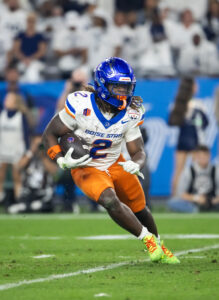 The Jags took the extraordinarily rare step of not conducting “30” visits. Teams naturally had less information regarding Gladstone’s plans, and Hunter even said he only spoke to the Jags at the Combine. The first report of Jags trade-up interest did not emerge until draft day, representing a well-kept secret on the Jaguars and Browns’ part. The teams had a deal in place for three weeks, provided Hunter was on the board at No. 2. The Browns did host Hunter on a “30” visit but will play the long game, trading down for Graham and eyeing the 2026 draft for a likely QB strike.
The Jags took the extraordinarily rare step of not conducting “30” visits. Teams naturally had less information regarding Gladstone’s plans, and Hunter even said he only spoke to the Jags at the Combine. The first report of Jags trade-up interest did not emerge until draft day, representing a well-kept secret on the Jaguars and Browns’ part. The teams had a deal in place for three weeks, provided Hunter was on the board at No. 2. The Browns did host Hunter on a “30” visit but will play the long game, trading down for Graham and eyeing the 2026 draft for a likely QB strike.
In doing so, the Browns gave up their chance to install Hunter in their offense. While Cleveland had viewed Hunter as a wide receiver — a view not every team shared — the 2024 Heisman winner instead became a player Jacksonville will build around as Coen and Gladstone take over. This draft was viewed to feature a line of demarcation in terms of value, with Hunter and Abdul Carter residing as the clear-cut top two prospects. Rather than settle for a high-second-tier player in a thinner pool, the Jags pounced.
Even though the team moved only from No. 5 to No. 2 (and did so for a non-quarterback), Hunter’s unique prospect profile proved costly for the Jags. It stripped them of a 2025 second-round pick and their 2026 first-rounder. During Khan’s ownership tenure, the Jaguars have made a staggering 11 top-10 picks. Hunter is the ninth top-five draftee for the Jags since 2012. The Browns are betting against the 2025 Jaguars, and the AFC South club’s history provides good reason for it.
 The Jags, who followed their two No. 1 picks earlier this decade with two 9-8 seasons, will plan on Hunter reversing this pattern. Viewing the Colorado talent as a rare performer due to his two-way capabilities, Gladstone determined this skillset justified the cost.
The Jags, who followed their two No. 1 picks earlier this decade with two 9-8 seasons, will plan on Hunter reversing this pattern. Viewing the Colorado talent as a rare performer due to his two-way capabilities, Gladstone determined this skillset justified the cost.
While Charles Woodson and Champ Bailey moonlit on offense in college, Hunter carried a true two-way workload. Hunter surpassed 700 snaps on offense and defense last season, averaging 114 per game. That separated him from the two-way players of recent eras and garnered the Deion Sanders pupil the Heisman, despite Jeanty’s rushing dominance. Hunter posted a 96-1,258-15 stat line on offense while intercepting four passes and deflecting 11 more on defense. The former Jackson State recruit did not approach these numbers in his Division I-FBS debut in 2023 (57-721-5 on offense), but he missed three games due to injury.
At first, scouts leaned corner for Hunter’s better position. Gearing to draft Cam Ward, the Titans offered a candid opinion and agreed CB was his ideal path. The Tennessee rival, though, differed in its stance. Hunter, 22, is primarily set to play receiver in Jacksonville. But the team gave its prized draftee cornerback reps during the offseason program. On days Hunter worked at corner during the Jags’ workouts, he only went through defensive drills. On receiver days, vice versa. In training camp, however, he will spend some days receiving offensive and defensive work.
Although Sanders moonlit at wide receiver in Atlanta and Dallas, Hunter does not have a modern-game comp, making it interesting to see how much CB work the Jags will really give him. Teams will undoubtedly attempt to pick on the 6-foot-1 rookie when he lines up at corner, as there is a reason true two-way workloads — post-Chuck Bednarik‘s 1963 retirement — have not transpired.
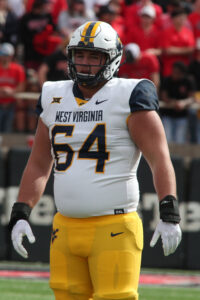 It will also be interesting to see how much the team’s CB plans limit Hunter’s WR work, as the Jags have not decided his in-game workloads just yet. For non-QBs, Hunter’s role might be the most interesting rookie-year storyline of the 21st century.
It will also be interesting to see how much the team’s CB plans limit Hunter’s WR work, as the Jags have not decided his in-game workloads just yet. For non-QBs, Hunter’s role might be the most interesting rookie-year storyline of the 21st century.
After sitting out the second round, the Jags traded No. 70 to the Lions before taking Ransaw. They then climbed back up to add Milum one pick later. An equation in which Mekari slides back to tackle would move the 2023 Harrison investment toward sunk-cost status, but Milum going outside the top 80 likely makes him a backup to watch to open 2025. Milum also started 43 games at tackle at West Virginia, making that a potential option in the event a guard conversion cannot commence.
Transferring from Troy to Tulane, Ransaw played in the slot frequently for the Green Wave and could factor in as depth behind Lewis there. Murray received two guaranteed years, and Darnell Savage is also in place at safety. But Ransaw will be an interesting project — particularly as Hunter will have a DB role. Ransaw brings 4.33-second speed to the equation, giving the Jaguars intriguing options.
Other:
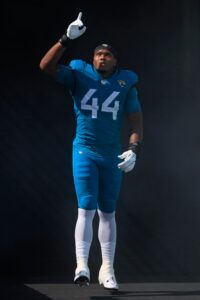 Yes, Baalke’s Walker-over-Hutchinson pick is behind on the scorecards. But Walker has quietly delivered back-to-back quality seasons. The 2022 top pick enters 2025 on the heels of 10- and 10.5-sack showings, the latter coming in a season with fewer pass-rushing situations. Walker forced two fumbles and notched 13 TFLs in 2024, and his 29 QB pressures ranked 23rd last season.
Yes, Baalke’s Walker-over-Hutchinson pick is behind on the scorecards. But Walker has quietly delivered back-to-back quality seasons. The 2022 top pick enters 2025 on the heels of 10- and 10.5-sack showings, the latter coming in a season with fewer pass-rushing situations. Walker forced two fumbles and notched 13 TFLs in 2024, and his 29 QB pressures ranked 23rd last season.
The Georgia product figures to always be compared to Hutchinson, who has proven to be a more disruptive rusher through three seasons, but the Jags have a talented D-end of their own. Walker’s rookie deal still complements Hines-Allen’s $28.25MM-per-year pact, one that carries a $10.5MM 2026 guarantee before two nonguaranteed years.
At 24, Walker is three years younger than Hines-Allen. This will be a pivotal year for Walker, as he can boost his value significantly. With a 2027 franchise tag potentially in the equation, the Jags also do not have to rush here, as the $14.75MM works out favorably for the team next year.
The CBA grouping all linebackers together under the fifth-year option, teams are declining ILBs’ options en masse. No team has picked one up since the Buccaneers exercised Devin White‘s in 2022; that decision backfired. The 2020, ’21 and ’22 ILB classes have not seen an option exercised; this includes the Ravens declining Patrick Queen‘s.
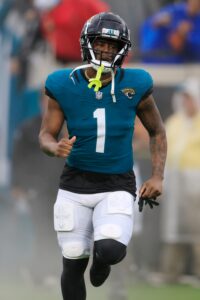 After making just two tackles for loss during his first two seasons combined, Lloyd recorded seven last season. Pro Football Focus has graded Lloyd as a top-15 linebacker in each of the past two seasons, but he will be tasked with playing in a third defense in four years. The Utah alum figures to be a player the new regime considers re-signing before free agency, but the market figures to treat him well come March.
After making just two tackles for loss during his first two seasons combined, Lloyd recorded seven last season. Pro Football Focus has graded Lloyd as a top-15 linebacker in each of the past two seasons, but he will be tasked with playing in a third defense in four years. The Utah alum figures to be a player the new regime considers re-signing before free agency, but the market figures to treat him well come March.
Reports of the Jags dangling Etienne in trades surfaced around the draft, and the team then chose fourth- and seventh-round running backs. Etienne had been a workhorse for the Jags prior to 2024, recovering from a rookie-year foot injury to post 1,441- and 1,484-yard seasons from scrimmage. Instrumental in the Jags’ 2022 playoff season, Etienne lost a crucial Week 1 fumble last year and saw Tank Bigsby eat into his workload in a disappointing 2024 campaign.
A report indicating Coen was not high on Etienne also surfaced post-draft. While Coen said the team does not intend to trade Etienne (tied to a $6.14MM fifth-year option), this is something to monitor thanks to the team’s draft decisions.
Top 10 cap charges for 2025:
- Trevor Lawrence, QB: $17MM
- Josh Hines-Allen, DE: $15.37MM
- Travon Walker, DE: $11.89MM
- Foye Oluokun, LB: $11.47MM
- Walker Little, LT: $10.94MM
- DaVon Hamilton, DT: $10.81MM
- Dyami Brown, WR: $9.99MM
- Travis Hunter, WR/CB: $8.48MM
- Tyson Campbell, CB: $8.03MM
- Arik Armstead, DT: $7.4MM
While blowouts at the Bills and Lions’ hands skewed the Jaguars’ 2024 point differential (minus-115), Pederson’s squad went 3-10 in one-score games. Several pieces from over-.500 Jags teams remain here; Lawrence, Hines-Allen and Campbell’s contracts still anchor the payroll. The team also plays in what has been the AFC’s worst division for many years, opening a narrow door in the event Coen can coax more from Lawrence.
Squinting could make this situation Chargers-like, as Lawrence was a coveted prospect like Justin Herbert. The Jags beating the Bolts in the 2022 wild-card round strengthens this comparison. Though, Harbaugh and Greg Roman carried far more experience (and higher pedigrees) compared to Coen and Udinski. The Jags are making a monster bet on Coen, whose lack of seasoning coupled with his organizational power create an unusual combination. This coming as Gladstone enters his mid-30s leaves an obvious void.
Lawrence displaying he has the tools to justify his contract would be a win for this Jags team in a stacked AFC, a conference that added Bo Nix and Drake Maye to its QB gauntlet. The fifth-year Jaguar’s trajectory veering the other way would invite major questions as to this operation’s viability, as full guarantees on his extension stretch into 2027. Hunter and Brian Thomas Jr. will be in place to help Coen attempt to replicate a Mike Evans–Chris Godwin setup, and the Jags are staking their plan on Mayfield’s 2024 being a blueprint for Lawrence’s ’25.
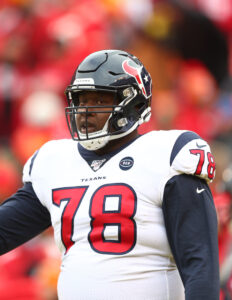 ESPN’s pass block win rate metric slotted Tunsil just outside the top 10 in 2023 and ’24, and the nine-year veteran had stayed mostly healthy since his injury-plagued 2021. Tunsil represented a key component in the Texans’ Stroud developmental effort, and they will pivot from a five-time Pro bowler (all five nods coming in Houston) to an eight-year vet (Cam Robinson) without any honors on his resume. Though, the Texans addressed this position early in the draft as well.
ESPN’s pass block win rate metric slotted Tunsil just outside the top 10 in 2023 and ’24, and the nine-year veteran had stayed mostly healthy since his injury-plagued 2021. Tunsil represented a key component in the Texans’ Stroud developmental effort, and they will pivot from a five-time Pro bowler (all five nods coming in Houston) to an eight-year vet (Cam Robinson) without any honors on his resume. Though, the Texans addressed this position early in the draft as well.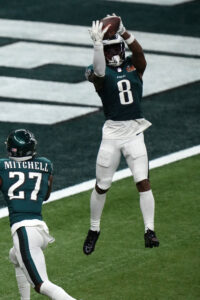 Gardner-Johnson is an interesting bet, especially in giving up an underperforming guard. Two years also remain on the two-time Super Bowl starter/renowned trash talker’s three-year, $27MM contract. No guaranteed money remains on Gardner-Johnson’s deal post-2025, giving the Texans flexibility if this fit does not work out. The Eagles have now ended both CJGJ’s stints at one season, letting him walk (to the Lions) in 2023 and trading him for a Becton replacement option after the second season.
Gardner-Johnson is an interesting bet, especially in giving up an underperforming guard. Two years also remain on the two-time Super Bowl starter/renowned trash talker’s three-year, $27MM contract. No guaranteed money remains on Gardner-Johnson’s deal post-2025, giving the Texans flexibility if this fit does not work out. The Eagles have now ended both CJGJ’s stints at one season, letting him walk (to the Lions) in 2023 and trading him for a Becton replacement option after the second season.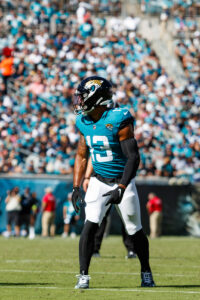 The Jags’ 2023 freefall came just after Kirk’s season-ending core muscle malady. They went 1-5 without Kirk available down the stretch. The former Cardinals second-round pick had notched his first 1,000-yard season (1,108) in 2022 to justify a contract most labeled outlandish earlier that year. Kirk then beat that per-game yardage number by averaging a career-best 57.6 in 2023.
The Jags’ 2023 freefall came just after Kirk’s season-ending core muscle malady. They went 1-5 without Kirk available down the stretch. The former Cardinals second-round pick had notched his first 1,000-yard season (1,108) in 2022 to justify a contract most labeled outlandish earlier that year. Kirk then beat that per-game yardage number by averaging a career-best 57.6 in 2023.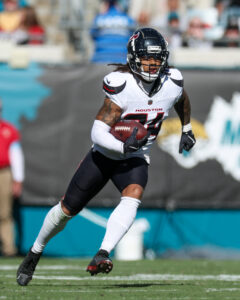 After an abbreviated rookie season, Stingley has become one of the NFL’s best cornerbacks. Caserio’s initial first-round pick as a GM hit big, intercepting five passes in back-to-back seasons and reaching the first-team All-Pro level. The Texans chose Stingley one spot over Sauce Gardner in 2022, and while the LSU product initially trailed the physical Jets cover man, a changing of the guard occurred — as the No. 1 contender for Patrick Surtain‘s belt, if you will — in 2024.
After an abbreviated rookie season, Stingley has become one of the NFL’s best cornerbacks. Caserio’s initial first-round pick as a GM hit big, intercepting five passes in back-to-back seasons and reaching the first-team All-Pro level. The Texans chose Stingley one spot over Sauce Gardner in 2022, and while the LSU product initially trailed the physical Jets cover man, a changing of the guard occurred — as the No. 1 contender for Patrick Surtain‘s belt, if you will — in 2024.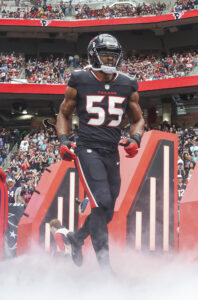 Although Stingley does not have a runaway lead in terms of two- and three-year cash flows like he does in CB AAV, it was still surprising to see the Texans agree to make him the NFL’s first $30MM-per-year DB on just a three-year contract. The corner market did not move between May 2022 and September 2024, needing Surtain to break through a $21MM-per-year ceiling — one that had fallen behind safeties by spring 2024. Seeing Surtain and Jalen Ramsey set the table, Stingley collected the final piece of leverage when Jaycee Horn scored a then-market-setting $25MM-per-year deal in early March.
Although Stingley does not have a runaway lead in terms of two- and three-year cash flows like he does in CB AAV, it was still surprising to see the Texans agree to make him the NFL’s first $30MM-per-year DB on just a three-year contract. The corner market did not move between May 2022 and September 2024, needing Surtain to break through a $21MM-per-year ceiling — one that had fallen behind safeties by spring 2024. Seeing Surtain and Jalen Ramsey set the table, Stingley collected the final piece of leverage when Jaycee Horn scored a then-market-setting $25MM-per-year deal in early March. Hunter, 30, tacked a fifth Pro Bowl onto his resume with a 12.5-sack season. The Texans-Vikings’ Hunter-Jonathan Greenard free agency switch proved a win-win, as the latter earned Pro Bowl recognition as part of a top-five Minnesota defense. Since returning from a 2021 chest injury, Hunter has not missed a game and has displayed consistency by staying between 22 and 23 QB hits in each of those three seasons. Being paired with Anderson will allow a good chance at a seventh double-digit sack season, while his presence helped the younger rusher make strides forward.
Hunter, 30, tacked a fifth Pro Bowl onto his resume with a 12.5-sack season. The Texans-Vikings’ Hunter-Jonathan Greenard free agency switch proved a win-win, as the latter earned Pro Bowl recognition as part of a top-five Minnesota defense. Since returning from a 2021 chest injury, Hunter has not missed a game and has displayed consistency by staying between 22 and 23 QB hits in each of those three seasons. Being paired with Anderson will allow a good chance at a seventh double-digit sack season, while his presence helped the younger rusher make strides forward.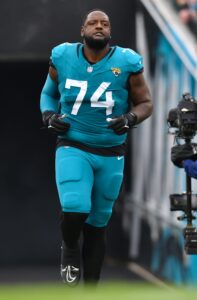 Having a biannual look at Robinson through his AFC South past, the Texans decided to add one of this market’s top players days into free agency. While it appeared Robinson’s market — thanks to Ronnie Stanley and Alaric Jackson taking themselves off the table via pre-free agency agreements — would rival Dan Moore Jr.‘s, the longtime Jags LT-turned-Vikings stopgap took a one-year accord with an eye on 2026. Based on the Texans’ offseason, this looks set to be a one-year partnership.
Having a biannual look at Robinson through his AFC South past, the Texans decided to add one of this market’s top players days into free agency. While it appeared Robinson’s market — thanks to Ronnie Stanley and Alaric Jackson taking themselves off the table via pre-free agency agreements — would rival Dan Moore Jr.‘s, the longtime Jags LT-turned-Vikings stopgap took a one-year accord with an eye on 2026. Based on the Texans’ offseason, this looks set to be a one-year partnership.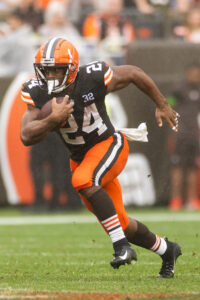 Chubb, 29, had taken a steep Browns pay cut after his 2023 knee injuries — a partially torn ACL, a fully torn MCL along with medial capsule and meniscus damage — and is certainly at a make-or-break point. The former second-round pick had zoomed to four straight Pro Bowls, running behind a well-built Browns O-line. This included two 1,400-plus-yard rushing seasons (2019, 2022), the first of which coming before the team rebuilt its O-line.
Chubb, 29, had taken a steep Browns pay cut after his 2023 knee injuries — a partially torn ACL, a fully torn MCL along with medial capsule and meniscus damage — and is certainly at a make-or-break point. The former second-round pick had zoomed to four straight Pro Bowls, running behind a well-built Browns O-line. This included two 1,400-plus-yard rushing seasons (2019, 2022), the first of which coming before the team rebuilt its O-line.